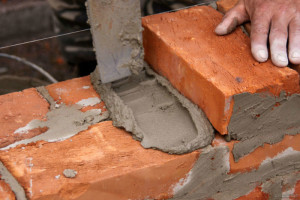With warmer temperatures finally here and summer just around the corner, many of us are content to close up our fireplaces until fall. However, if your chimney needs masonry repairs now may be the best time to have them done!

What causes masonry damage?
While bricks and mortar are one of the strongest building materials on the planet, they cannot stand up to everything. Because of this, there are a number of things that can damage your masonry. One of the most common causes of masonry damage is water. Long term exposure to moisture, such as puddles of standing water on the chimney or areas that sprinklers hit with every pass, are at greater risk of damage such as cracking and spalling. This type of damage can often be exacerbated by winter weather conditions; this is why masonry damage is more commonly discovered in the spring.
Signs of masonry damage
Masonry damage can be as minor as a small crack in the mortar or as major as entire chunks of brick or stone falling away from the structure. While a chimney inspection is often needed to pinpoint small areas of damage, the following are signs that your masonry may need to be repaired.
– Chips or cracks
– Missing pieces of bricks or mortar
– Stained masonry
– Long-term growth of ivy or other climbing plants on masonry
– Chimney leaks
Why should I schedule my masonry repairs now?
While spring might not be known as a time of heavy fireplace use, it is often the best time to have your masonry repaired. Below are some of the reasons why you should think ahead and schedule your masonry repairs today.
– Flexible scheduling: Spring is often considered the “off season” for chimneys. Because of this, it is easier to get a flexible appointment time that fits into your busy schedule.
– Mild temperatures: Many masonry repairs require mild temperatures and weather in order to be done. Because of this, some repairs cannot be completed in the cold of winter or the heat of summer, giving spring the ideal weather conditions for repairs.
– Ready to use: If you have your masonry repaired in the spring when you are not regularly using your fireplace, it will be ready to go again the fall when temperatures begin to fall. This gives you the advantage of a fireplace that is ready to use as soon as the first cold snap arrives.
Our masonry services
At Jack Pixley Sweeps, we can clean your chimney inside and repair your masonry outside. We are proud to offer our customers a wide range of masonry services that will keep your fireplace system looking beautiful and burning safely. Our skilled masons can handle any chimney repair, from small areas of tuckpointing or flashing repair to rebuilding your chimney from the ground up.
Don’t put off your masonry repairs until fall. Instead, schedule your masonry work this spring to get the best appointment flexibility and have your fireplace ready to use again in the fall. Contact Jack Pixley Sweeps today to schedule your masonry work today!

Spring is the perfect time to get your chimney’s brickwork repaired!
Winter can be a particularly rough time of year for fireplace systems. In addition to heavy use, chimneys are also faced with exposure to the harsh winter elements, including frigid temperatures, ice, snow, and freezing rain. Because of this, many homeowners find that their masonry fireplaces and chimneys are in need of repair when spring finally arrives.
Spring is the perfect time of year to have masonry repair work done. The mild temperatures and conditions allow work to be quickly completed with a minimum of weather-related delays. Likewise, because most homeowners do not use their fireplaces in the spring, our appointments for spring masonry repairs are often quickly filled.
Water damage and your masonry chimney
Chimneys are built strong to withstand the force of the elements. However, even the best built chimneys have one major enemy: water.
Water damage can quickly damage any masonry structure, sometimes in as little as one season. Although bricks are designed to be naturally porous, too much water can overwhelm them. When water is absorbed by the bricks during the winter, it freezes and expands. When the water melts, it leaves behind bigger cracks and holes, allowing even more water to enter the bricks. This freeze thaw process can lead to bricks cracking and even falling away from the chimney structure if left unrepaired.
Water can also find its way into your fireplace and chimney system through defective chimney caps, damaged or improperly installed flashing, or due to a number of other possible causes. Because it can be difficult to pinpoint the cause of water entry and damage, it is recommended to have your entire chimney system professionally evaluated if a leak is apparent.
Why is chimney maintenance important?
While a few small cracks in the brick may not seem like a major issue, if left unrepaired it can quickly turn into one. Unrepaired chimney damage will only continue to get worse, jeopardizing the health and safety of you and your family. Even no longer using the fireplace is a good option; even if you aren’t using your damaged fireplace, the masonry will still continue to decay.
In order to identify and repair masonry damage as soon as possible, it is recommended that homeowners have a chimney inspection performed each year. “A chimney inspection is like an annual dental check-up,” says Ashley Eldridge, Director of Education for the CSIA. “It’s preventative maintenance that helps minimize potential hazards.”
Our masonry services
At Jack Pixley Sweeps, we can do much more than just clean your chimney. We offer a wide range of masonry services for our customers. Since 1977 we have proudly been providing high quality masonry services to our friends and neighbors in the Saint Paul and Minneapolis area.
Unlike a general contractor, our skilled masons are knowledgeable about the codes, clearances, and other safety standards associated with rebuilding and repairing masonry chimneys. In addition, by choosing a chimney company to make the repairs you can rest assured that our masonry work will be not only aesthetically beautiful, but also safe and functional.
Our spring schedule has already begun filling up with masonry repair appointments. If your chimney needs to be repaired, don’t wait any longer – contact Jack Pixley Sweeps today to schedule your spring masonry repairs!
Fireplaces continue to be beautiful additions to many homes. Additionally, many homeowners find that they rely on them in winter to add warmth and comfort to their homes.
Despite their popularity and widespread use, most people do not understand how their chimneys work. This can sometimes lead to homeowners misidentifying the cause of an issue or not realizing it is time for maintenance.
The following are some of the most important components of your chimney that many people are unfamiliar with. Learning more about the anatomy of your chimney can help you identify and understand any chimney issues you may have in the future.

Chimney cap
The chimney cap covers the top entrance of your flue, allowing smoke to safely exit while preventing water, animals, and debris from getting in. Uncapped chimneys or those with damaged caps are more likely to have issues with water damage, blockages, or animals nesting in the chimney.
Chimney crown
A chimney crown is a slab, typically made of concrete, which protects the masonry of your chimney. Damaged chimney crowns may allow water into the chimney structure or allow the masonry of the chimney to receive water damage.
Chimney chase cover
Similar to a chimney crown, a chimney chase cover protects the top of the chimney. Typically made of metal, chase covers were used regularly in the 1970s and 1980s with factory built or prefabricated chimneys. Over time, chimney chase covers may deteriorate, causing rust stains on the masonry of the chimney.
Chimney damper
The chimney damper separates the firebox from the flue. Open and closed using a pulley or a lever, the damper prevents heated or air conditioned air from escaping as well as minimizing drafts. Likewise, dampers help prevent moisture, debris, or animals from getting into the firebox. While dampers should be closed when the fireplace is not in use, the damper should always be opened before starting a fire to prevent smoke from backing up into a room.
Chimney flue
The chimney flue is the chamber through which smoke, gas, and other byproducts of combustion are vented to the outside.
Chimney flue lining
Chimney flue liners protect the surrounding building materials from the hot air, smoke, gas, and other byproducts of combustion that are travelling up the flue. There are three main types of flue linings: clay tiles, metal, or cast in place. Over time, creosote can build up on the flue lining. This byproduct of combustion is highly flammable, and it’s removal is the primary purpose of annual chimney sweepings.
Smoke chamber
The smoke chamber is designed to help compress smoke from the firebox into the flue without creating a backdraft. Smoke chambers are created with a sloping wall just above the firebox. A well designed smoke chamber with allow smoke, gas, and other byproducts of combustion to smoothly and quickly travel up the flue.
Smoke shelf
Located behind the damper, the smoke shelf is designed to catch any water or debris that enters the chimney. The smoke shelf also helps compress the large amounts of smoke created in the firebox to the much smaller entrance to the flue.
Chimneys are complex structures with a number of working parts that must be kept up in order to keep your fireplace working well. Contact the experts at Jack Pixley Sweeps today to schedule a sweeping and inspection to ensure your fireplace and chimney are in prime condition.



